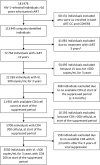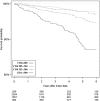Long-term mortality in HIV-positive individuals virally suppressed for >3 years with incomplete CD4 recovery
- PMID: 24457342
- PMCID: PMC6276895
- DOI: 10.1093/cid/ciu038
Long-term mortality in HIV-positive individuals virally suppressed for >3 years with incomplete CD4 recovery
Abstract
Background: Some human immunodeficiency virus (HIV)-infected individuals initiating combination antiretroviral therapy (cART) with low CD4 counts achieve viral suppression but not CD4 cell recovery. We aimed to identify (1) risk factors for failure to achieve CD4 count >200 cells/µL after 3 years of sustained viral suppression and (2) the association of the achieved CD4 count with subsequent mortality.
Methods: We included treated HIV-infected adults from 2 large international HIV cohorts, who had viral suppression (≤500 HIV type 1 RNA copies/mL) for >3 years with CD4 count ≤200 cells/µL at start of the suppressed period. Logistic regression was used to identify risk factors for incomplete CD4 recovery (≤200 cells/µL) and Cox regression to identify associations with mortality.
Results: Of 5550 eligible individuals, 835 (15%) did not reach a CD4 count >200 cells/µL after 3 years of suppression. Increasing age, lower initial CD4 count, male heterosexual and injection drug use transmission, cART initiation after 1998, and longer time from initiation of cART to start of the virally suppressed period were risk factors for not achieving a CD4 count >200 cells/µL. Individuals with CD4 ≤200 cells/µL after 3 years of viral suppression had substantially increased mortality (adjusted hazard ratio, 2.60; 95% confidence interval, 1.86-3.61) compared with those who achieved CD4 count >200 cells/µL. The increased mortality was seen across different patient groups and for all causes of death.
Conclusions: Virally suppressed HIV-positive individuals on cART who do not achieve a CD4 count >200 cells/µL have substantially increased long-term mortality.
Keywords: CD4 cell recovery; HIV; mortality; risk factors; sustained viral suppression.
Figures


References
-
- Lohse N, Hansen AB, Pedersen G, et al. Survival of persons with and without HIV infection in Denmark, 1995–2005. Ann Intern Med. 2007;146:87–95. - PubMed
-
- El-Sadr WM, Lundgren JD, Neaton JD, et al. CD4+ count-guided interruption of antiretroviral treatment. N Engl J Med. 2006;355:2283–96. - PubMed
-
- The CASCADE Collaboration. Survival after introduction of HAART in people with known duration of HIV-1 infection. Concerted Action on SeroConversion to AIDS and Death in Europe. Lancet. 2000;355:1158–9. - PubMed
-
- Moore RD, Keruly JC. CD4+ cell count 6 years after commencement of highly active antiretroviral therapy in persons with sustained virologic suppression. Clin Infect Dis. 2007;44:441–6. - PubMed
Publication types
MeSH terms
Substances
Grants and funding
LinkOut - more resources
Full Text Sources
Other Literature Sources
Medical
Molecular Biology Databases
Research Materials

